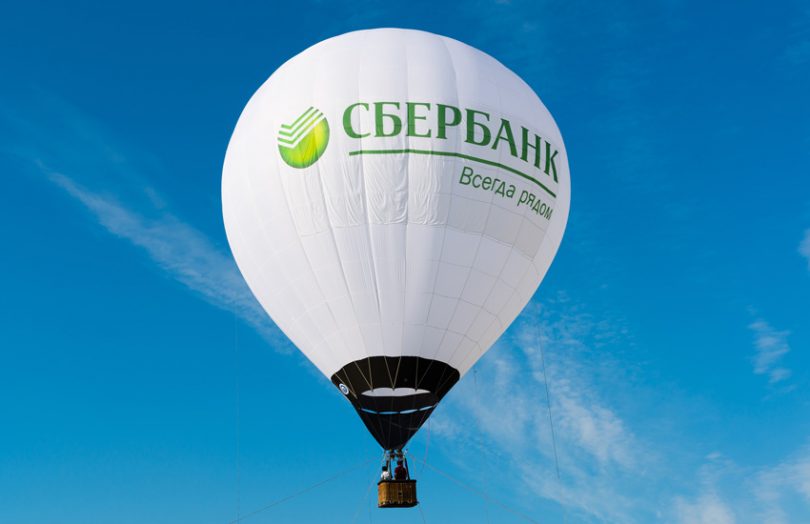Russia’s largest bank, Sber, has massive plans for blockchain and its settlement token, often referred to as Sbercoin. The tokenized bank money sits at the heart of a plan to build an open blockchain ecosystem where developers can build new products and business models, all settled in digital fiat money. Despite the big ambitions, the question remains whether the central bank will grant approval.
“We could be the very first in the world (to launch an) open platform where you can deploy and execute smart contracts that will settle in (tokenized) fiat currency. And behind that platform is not a fintech startup, but the largest bank in the country,” said Oleg Abdrashitov, the head of Sberbank’s Blockchain Lab. The Lab is one of several, including for AI, robotics, and augmented reality, to transform the state-controlled bank into a technology company.
Abdrashitov resisted the label Sbercoin and emphasized that it is not a stablecoin. “The coins that you see on the platform, they’re not mined. They’re not exactly minted,” said Abdrashitov. “It’s just another representation of the money that our clients have with the bank.”
Sberbank’s plans include using the tokenized money to settle transactions on Sberbank’s soon-to-launch digital assets platform. While that might be the sexy use case, there are two other significant ones. One is writing smart contract applications around the money, such as conditional payments and trade finance solutions. Because Sber’s platform is a curated one that is open to developers, these solutions will be built not only by the bank but by its clients as well. Another use case is to trace money to ensure loans and investments are used for their intended purpose.
Digital Assets
Last year Russia passed new digital assets legislation that created a massive opportunity for banks by enabling the issue of regulated Digital Financial Assets (DFAs). Operators of digital asset platforms have to be Russian entities authorized by the Central Bank. The definition of DFAs is broad, which means companies can issue tokens for stocks, commodities, bonds, commercial paper, and more, including their use in smart contracts. While the law came into effect at the start of the year, Sber is currently finalizing the approval process of its DFA platform.
In the meantime, using the same technology, last year, Sberbank soft-launched a renewable energy certificate (REC) platform, which it sees as a utility token rather than a financial asset. The bank is starting to actively build a market for trading the certificates between corporates, producers and individuals.
Smart contracts and DeFi-like solutions
Beyond settling deals with digital assets, the second use case is to enable the tokenized money to be used in smart contracts. As a developer, this was the one that captured Abdrashitov’s imagination. “The platform will be open for developers where they can deploy smart contracts, new products and do magic similar to what you have now with decentralized finance (DeFi),” said Abdrashitov.
Clients or fintechs can develop new financial products based on smart contracts. Given the importance of commodities in Russia, some applications are likely to revolve around supply chain and trade finance. These might include conditional payments, and Abdrashitov described the potential for advanced Letters of Credit that involve dozens of signals.
To enable numerous applications, Sber is launching a Blockchain as a Service hosting solution in its SberCloud.
Traceable money
Perhaps traceable money might have helped prevent the recent collapse of supply chain finance firm Greensill, resulting in losses for Credit Suisse investors and SoftBank. Supply chain finance is typically low cost because it’s backed by invoices that large companies pay. In Greensill’s case, financing was used for some potential rather than actual sales, although it was allegedly disclosed to investors. With blockchain, where the money goes is more traceable and that’s a third application area Sberbank is pursuing.
“Imagine a million rubles that can be represented by unique tokens and you can see each individual ruble traveling from one supplier to another supplier to a subcontractor and so on. You can see the entire tree of payments. That’s a major application on the platform as well,” said Abdrashitov.
For example, if credit is granted for medical equipment, the lender can ensure that’s where the money goes. For a major investment project, the investor can see how the money is spent, likewise for government grants.
But we’d observe this will reduce but not prevent misspending or outright fraud. Without blockchain, someone could use the money on something else and misreport it. With blockchain, that person would have to lure other people into logging false information on the blockchain.
Looking at the big picture, while Sberbank is advanced with its plans for tokenized money, it still has to get a green light from the Bank of Russia.
Will the central bank allow Sber to tokenize money?
Last year, like several other countries, the Bank of Russia published a paper on central bank digital currency (CBDC). But unlike many others, our view is that the central bank’s report seemed a lot less concerned about how a CBDC might impact commercial banks. It matter of factly stated that if commercial bank deposits decline, the central bank can fill in the gap.
But more importantly, it has implied that a CBDC should be the only legal digital currency. The Central Bank’s plans have sparked significant debate within Russia’s banking community.
“Our ideas are only complementary to what the Bank of Russia and other central banks are proposing,” said Abdrashitov. “If you want to tokenize just one part of the money, the claim on the central bank, it only makes sense to do so for money in commercial banks.” He sees the biggest benefit as competition, particularly with the applications it enables.
Russia’s big advantages
Assuming for a moment that Sber gets the central bank go-ahead, why should Russia move any faster than other parts of the world? Firstly, there’s the regulatory clarity around Digital Financial Assets. But there’s also a technical reason.
In most countries, getting companies to use private keys and the like involves jumping through hoops. In Russia, all companies are issued with private keys and certificates by the government. They use these to log tax returns. But more importantly, the keys are used to sign legally binding contracts. So there’s a critical piece of infrastructure already in place capable of re-use for smart contracts.
A third advantage isn’t something Sber stated, but Russia has one of the deepest pools of top-notch development talent in the world. The question is whether that talent wants to work on DeFi or will find it appealing enough to work on enterprise blockchain Hyperledger Fabric. Later this year, Sber is planning a hackathon to help to build the ecosystem.
There’s one big contrast with DeFi. While many cryptocurrency onramps are compliant, the DeFi processes themselves are not. As a bank, all participants on Sber’s platform will be required to go through know your customer (KYC) compliance, and smart contracts and applications deployed on the platform will go thru stringent examination. And banks aren’t just compliant, they’re known for their rock-solid security.
Asked about the biggest challenges of building the platform, Abdrashitov said “providing the highest level of security and compliance and at the same time making it user friendly is a challenge.”







